India Pride Project: The Brainchild of an Indefatigable Art Vigilante
- In History & Culture
- 06:10 PM, Jan 29, 2022
- Vijay Kumar
In India, the gods are under siege. Ten thousand deity statues – an assortment of metal and stone sculptures – Gods, lintels, pillars, guardians, ornamental arches - have been stolen from temples over the past 20 years. The standing “stock” in the godowns of the looters run between 250 and 750 pieces – and these are just of individual “galleries” that have been peddling their wares for decades. Newcomers to the art trade use eBay to ply their own Indian antiquities using marine containers to ship them – audaciously declaring them as Garden furniture.
A casual google search on Indian art throws up hundreds if not thousands of stone and metal sculptures – up for sale, auction and in museums and art houses around the world. Most the stone sculptures are cut off at the leg or headless, leaving only the trunk or heads. The looting of India’s rich historical materiality was systematized by British colonial authorities. Contemporary looting involves a much wider range of people, methods, technologies, and artworks. Above all, modern looters make the immoveable moveable and the priceless priced.
Art loss is everywhere. Every day, it seems, we hear new stories about art theft and destruction, sometimes woven into narratives about attacks on cultural heritage in Syria, Iraq, and Afghanistan. There are scant records of these thefts compounded with a lack of National archive is leaving the culturally rich landscape impoverished.
In this dark space there is a ray of light: the India Pride Project, a grassroots effort to protect India’s temple treasures by documenting and tracking them. India has the second-highest per capita mobile phone usage rate in the world. The India Pride Project taps this network, asking villagers throughout the southern state of Tamil Nadu to do two simple things: take a smartphone photo of the deity statues in their local village, and send the photo to the project organizers along with basic object information. The results so far have surpassed all expectations: a growing database of south Indian temple treasure and newfound enthusiasm among villagers for protecting and learning about their cultural heritage. Thefts are tweeted, Facebook posts seeking information are shared and youtube campaigns launched – all aimed at raising awareness.
India Pride Project runs purely on volunteers. A select team of heritage enthusiasts from diverse fields connected by a common goal - of bringing heritage awareness and conservation to the next generation, who consider it their sacred duty to safeguard their ancestral treasures - not bound by religion or race. Their personal pursuits to rediscover their land opened their own eyes to the lost treasures – the largely self-taught group built their knowledge pool from published works but were appalled when their field trips revealed the true extant of loot – empty niches and plundered sanctums! The lack of documentation and reporting of thefts was endemic.
Not wanting to end with just empty lamenting, the group has taken the task head-on and their enthusiasm has are spread around the world. Volunteers working day jobs find time to contribute to the effort. Some mine online resources, others organise documentation workshops, temple tours while others reach out to far flung museums and art galleries even libraries in search of Indian Art – all to crowd source their dream - a digital database of sculptural art in India, which will not only support more detailed scholarly research but also promote conservation and more importantly act as a strong deterrent against looting.
They are restoring India’s Pride – playing their part in recent high profile restitutions but still only the tip of the proverbial ice berg !!
The man behind IPP is Vijay Kumar Sundaresan, 47, hardly sleeps. By day, he is a shipping professional, general manager of one of the world’s largest containerised shipping lines.
Come night, and Vijay dons a different avatar, driven by a passion for sculpture and Indian temple art.
Touted the hero who takes the plundering of India’s idols by the horns, Kumar is responsible for identifying countless Indian treasures stolen and smuggled overseas.
For him, it all began with an ardent interest in Chola kingdoms and his grandmother’s stories during his childhood. “I was also taken by the Tamil epic Ponniyin Selvan.” He knew there needed to be a repository of information on artefacts and idols that was accessible to the public and didn’t translate into Greek and Latin. “The formative scripts were written in an extremely difficult manner and I started a website called Poetry in Stone on the lines of a ‘dummies “series to address this.”
Vijay wanted this to become a “dummies guide to art”, to educate laymen. The blogging website has created a network of history buffs and heritage junkies. It shares information (through blogs, photographs and WhatsApp and Youtube posts) on Indian antiques or idols that contributors come across – be they in temples. art galleries, museums or private collections. “Poetry in Stone” has become the largest digital archive of Indian art outside India. It has raised awareness and action on national treasures, art thieves and smugglers, and helped bring them to book.
Since 1980 – in free India, not British India – some 10,000 pieces of Indian art worth about $10 billion (yes, $10 billion) have been stolen from India and made their way to galleries and museums and art collectors of the west. One reason is the poor state of knowledge about India’s sacred art treasures (some of which are housed in remote, dilapidated, little-guarded temples) and the apathy and inaction concerning their protection and preservation.
It is this lack of knowledge and this inaction that Vijay has sought to address through his website. Stolen idols and artefacts with museums and galleries abroad now get recognized. Proving where they emanated from, and proving the act of pillage -- that is a massive painstaking effort, and Vijay is at the vanguard of the movement.
Till 2012, 19 Indian antiquities had been brought back to India. Since 2012, thanks to Vijay Kumar’s crusades and Poetry in Stone, 300 antiquities have staged a ghar wapsi, and 1000 more will be back this year majorly from America.
In 2018 - Vijay’s book “The Idol Thief —The True Story of the Looting of India's Temples” (Juggernaut) was released. The book describes how New York-based art dealer, art smuggler and idol trafficker Subhash Kapoor, 69, was chased down by law enforcement authorities of India and the US, and the part Vijay played in the operation. Kapoor was arrested in Frankfurt in 2011 and brought to India in 2012. He is now in jail in Tiruchirapalli. Once he is released, he faces extradition proceedings to the US for trial there.
The book is now in its third print and has already been translated into Hindi, Tamil, Malayalam, Marathi.
Subash Kapoor owned “Art of the Past”, a glitzy store in Madison Avenue. He had spent three decades in the art world and had formed an extensive network of art collectors, curators and dealers in more than a dozen countries. He often engaged middlemen and petty local crooks to do the actual task of thieving from remote temples. Museums and collectors paid seven-digit sums for his Hindu, Buddhist and South Asian antiquities. He was “the most ambitious antiquities smuggler in American history”, to quote American authorities and the New York Times.
The New York Times says Vijay Kumar’s suspicions about Subash Kapoor were aroused when he noticed that Kapoor was selling an extraordinary number of rare Indian idols from New York. Vijay played an important part in Kapoor’s arrest, through the all-important documentation that Poetry in Stone provided.
What’s behind Vijay’s crusading zeal as art vigilante? Kalki Krishnamurthy’s “Poninyin Selvan” sparked his interest in art and history early in life. “I always felt a personal connect with emperor Raja Raja Chola especially in the big Tanjore temple,” he says. He acquired professional qualifications in accountancy and shipping, but he taught himself art history through books, films, temple visits and conversations. Internet was a boon of course. In course of time, thanks to his initiative and the passion of fellow-bloggers and cultural buffs, Poetry in Stone morphed into art vigilantism.
What are some of Vijay’s foremost achievements in the ghar wapsi of stolen Gods, apart from helping in the downfall of Kapoor’s evil empire? In September 2014, Australian Prime Minister John Abbott handed over to Prime Minister Narendra Modi two idols – an Ardhanari idol and a dancing Nataraja idol. Vijay Kumar’s painstaking documentation was instrumental in both successes.
The Ardhanareeswara was a 1,000-year-old stone sculpture from a temple in Vriddachalam, 200 km south of Chennai. This surfaced in 2013 in the Art Gallery of New South Wales, Sydney. Intriguingly, the temple authorities in Vriddhachalam, were ignorant of the theft. They were unaware that the idol in their own temple was a fake, a substitute.
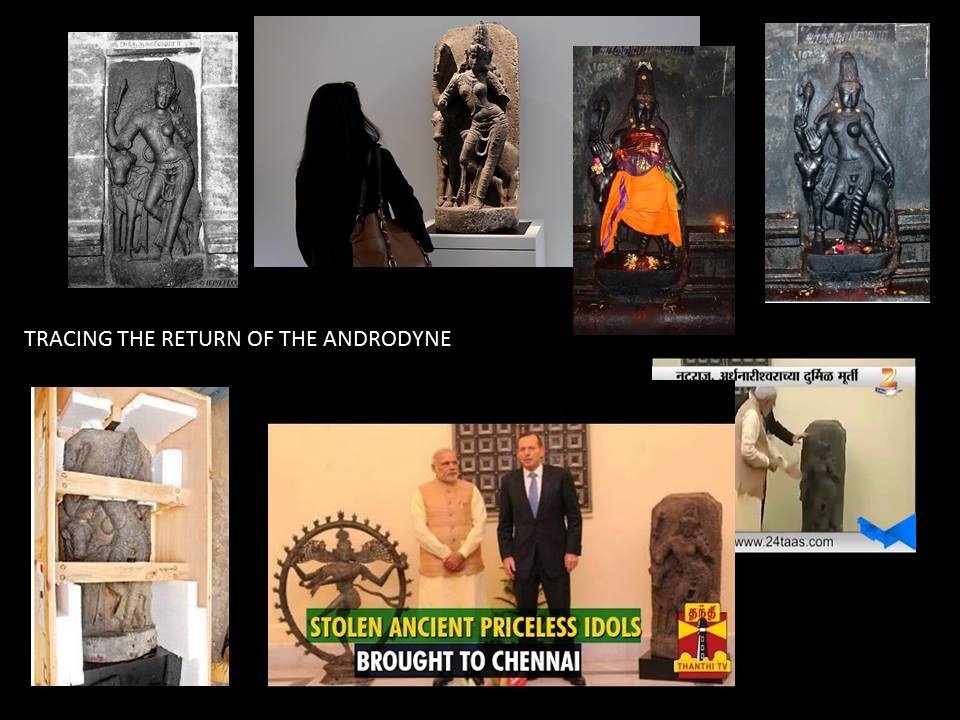
It’s Vijay Kumar who exposed the theft. He compared the Ardhanariswara idol in Australia with photographs from the French Institute of Pondicherry and published his finding on his blog site. Subsequent investigations involved the Tamil Nadu Police, the Hindu Religious and Charitable Endowments Board and The Hindu, the daily newspaper, An FIR was launched, and the idol was eventually back in India.
The story of the Nataraja? Actually, two Natarajas had been stolen from two temples – the Brihadeeswaran temple in Sripuranthan village near Jayamkondam, and the Sri Varadaraja Perumal temple in Suthamalli village, not far from Sripuranthan. The former had lost eight 11th century Chola idols and the latter 20 bronzes dating to the 11th century.
Vijay Kumar came up with detailed photos from the French Institute of Pondicherry archives to prove that the dancing Nataraja idols in Australia came from the Sripuranthan temple. The then curator of the Australian gallery argued that all Natarajas look similar. Vijay Kumar then came up with Youtube evidence which provided clear proof of the origin of the idol.
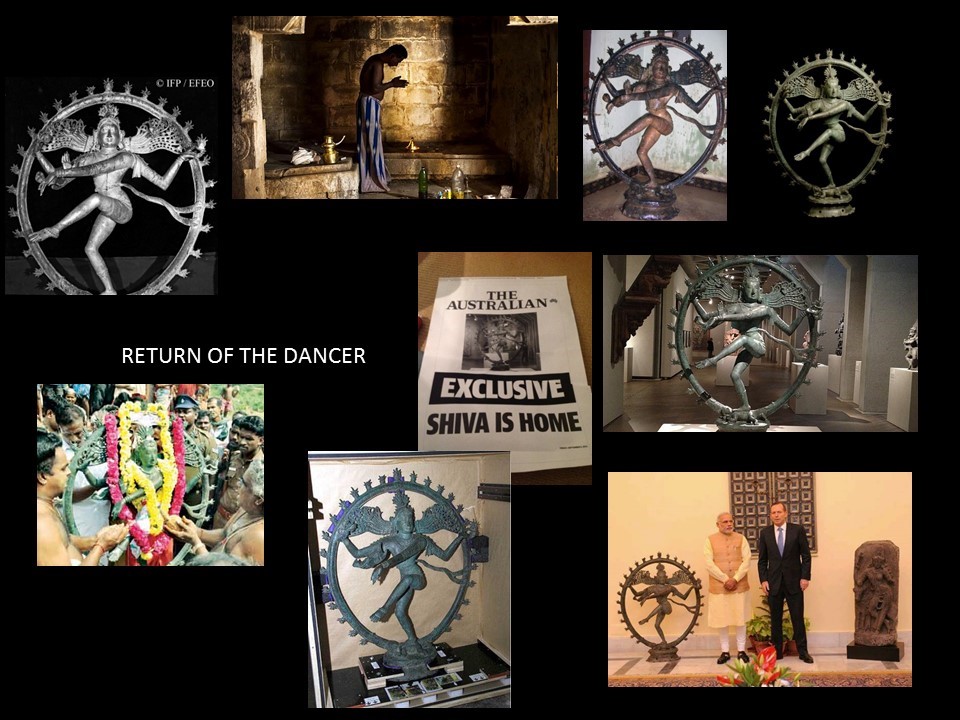
In 2016 Vijay embarked on a quest to trace a stolen Rama which ended in 2020 – with the dramatic restitution of the Anandamangalam Rama, Lakshmana and Sita Murthis stolen in 1978 from the temple from a UK dealer. The Hanuman of the group is still stuck in Diplomatic tussles between India and Singapore (currently with the Asian Civilisations Museum, Singapore)
The lead was cold – a grainy photograph of a bronze in the posture of holding a bow, was submitting by a volunteer – shot of antique shop window. It could be Rama or Laxmana. Artistically it rivalled any known Chola bronze but stylistically Vijay noticed it was of a different hand – a different dynasty. Experience of studying hundreds of bronzes honed him to a Rama Bronze group in the dimly lit hardly visited third floor of the Chennai Egmore Museum – a Vijayanagara bronze Rama group proved his hunch correct. The locale was in and around the erstwhile French colonies in Karaikkal. A further two years went in searching for temples in the region which had lost either a Rama or a Lakshmana or had a mismatched modern replacement. No luck, not before another tip off arrived. The same shop window shot but the bronze looked vaguely different. Closer inspection revealed the crown was different “could it be that the shop had both the Rama and a Lakshmana?”
Another search of reported thefts in the region didn’t provide any clues but after many hours of searching the Anandamanglam Rama temple came up on the IFP records. But Anandamanglam had only a Hanuman temple – a famous and special hanuman at that, but then investigations revealed that the temple was robbed of its main bronzes in 1978 ! The accused FIR closed ! Bingo !
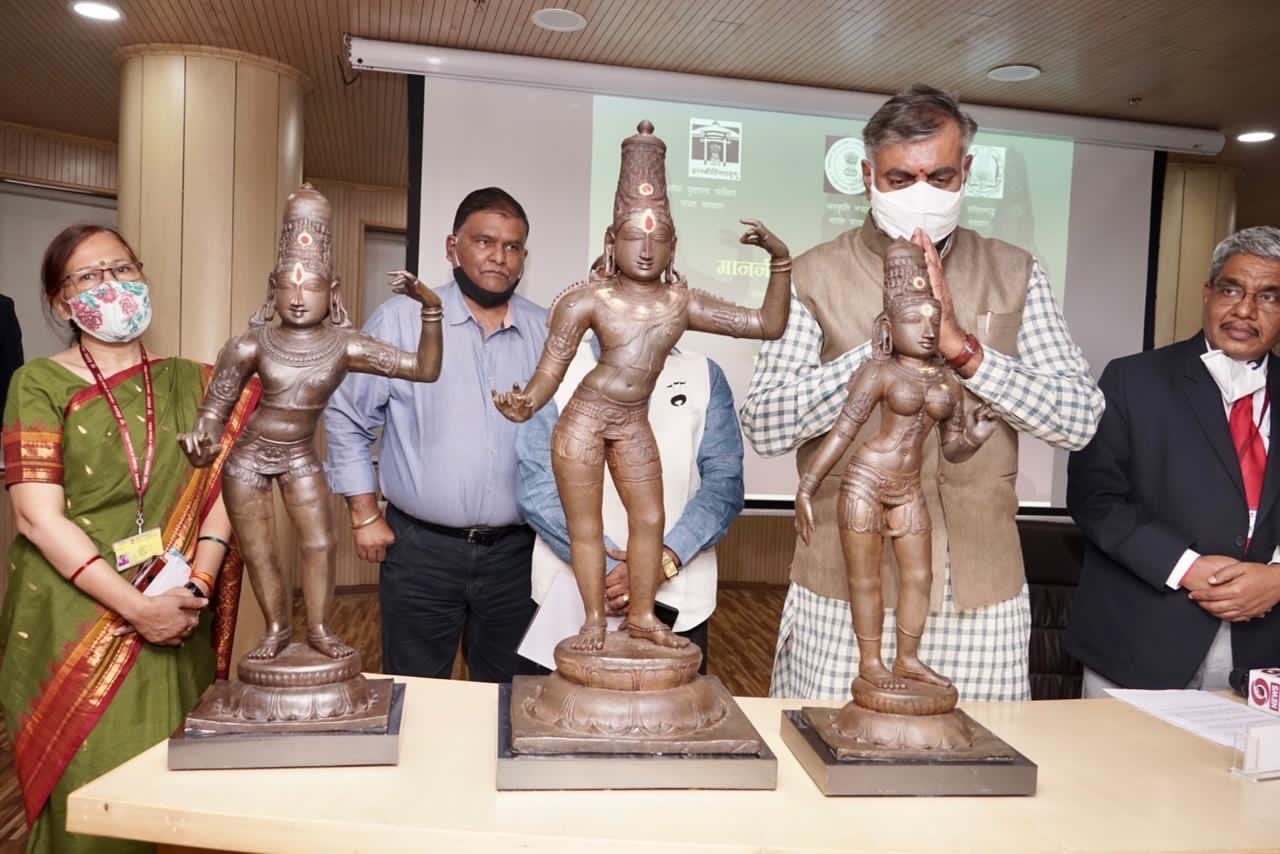
With hard evidence the HCI in London under the First Secretary drawing on experience from the Nalanda Buddha case took the evidence from IPP and confronted the dealer along with support from the MET Police Art crime Unit. What happened next was magic !!
The villagers rallied behind the temple and ensured they created all the security infra needed to convince the government that they can take care of their Gods and thus the Gods finally came home – from being show piece curios to being the living Gods there truly are-
Vijay Kumar’s work as art documentalist and vigilante has been recorded in the United Nations review on the fight against illicit trafficking of antiquities. He was invited to speak at the “Unite for Heritage” conference in Yale under the auspicious of UNESCO and UN. His help has been sought for capacity- building effort by global enforcement agencies including Interpol, Europol, the Customs in India, India’s ASI (Archaeological Survey of India) and CBI (Central Bureau of Investigation).
But a lot more needs to be done. Vijay says we should establish a national art squad, open up all cases and go after every cog in the art smuggling wheel – from the export licence to the shipping bill, to the antiquity certificate registration, to what happens at the Customs. Because corruption has to be tackled at all points. We must get tough with some banks, which are inadvertently assisting in laundering the funds.
The tide is turning against art smugglers and idol thieves. It is now a co-operative movement, but Vijay Kumar’s passion, his activism, his success in networking and the vigilantism of his website Poetry in Stone have played an important role.
Through this case study – we demonstrate how the illicit trade in antiquities is impoverishing a great land, impacting local communities and how targeted action groups are working with young volunteers in tapping technological tools, creating social media action groups and working with local and international law enforcement in creating a lasting deterrent.
In 2018 - a bronze statue of Buddha, excavated from Nalanda, Bihar, was returned to its rightful place 57 years after it was stolen. It was handed over by the UK’s Scotland Yard to India, after Vijay noticed that the Buddha on sale at The European Fine Arts Fair (Tefaf) in Maastricht, the Netherlands, was the stolen one, and alerted the authorities.
Between 1961 two thefts occurred at the ASI site museum in Nalanda, Bihar, India. The targets were one of the rarest of early Buddhist bronzes just excavated from the famed Nalanda ruins. They were so unique that no other sets have every been found of the same period on the site. Sadly, even before they were properly documented and studied, thieves stuck. On 22.08.1961, 14 of the small yet magnificent bronzes were stolen. Even before the impact of the theft was known widely on the night of 6th/7th March 1962 the robbers stuck again looted two more of the same. Interestingly no other objects were lost and lent credence to the belief that this was no random theft but a targeted hit at these specific bronzes.
There were rumours that one of the bronzes surfaced with the LACMA in 1975. Indian government has been unsuccessfully lobbying for its restitution without much success due to want of concrete evidence – till now.
Encouraged by reading media reports on the efforts of a small but dedicated group of volunteers working together as the India Pride Project, a retired employee of the Museum reached out to the team leader in Feb 2018. The octogenarian had been in-charge of the museum during the theft and had been at the receiving end of a departmental penalty for failing in his duty to protect the treasures. He had faithfully preserved his internal memos and in his personal collection a few (not all) photographs of the stolen bronzes. For some reason the national investigations of 1961 had failed to bring these to light and the old man’s last wish was to clear his name and see justice being done.
One of the photos is a perfect match to the LACMA 1975 acquisition. But that was not all – in March 2018, thanks to social media, one of our celebrated activists announced in a select group of an intention to visit TEFAF Maastricht and as usual we requested for update on any Indian art that was offered for sale. Apart from Indian art, there was another UK dealer who was displaying a Buddha as Himalayan Art. The grainy images via initial sharing looked vaguely familiar. For the Nalanda bronzes were so unique and even though the artefact had been through some major restoration and possible rework the tell-tale marks were unmistakable. A second visit to the stall and high resolution images and our hard work have since provided a conclusive match. Currently India has formally lodged its claims with our detailed matching work for both the artefacts.
This is a classic case of maintaining a proper lost archive but also for the need for it to remain confidential and secure. For the Tefaf Buddha was fenced almost for five decades before coming up for sale! This case is also a great example of how cooperation and knowledge sharing amongst heritage custodians can combat art crime.
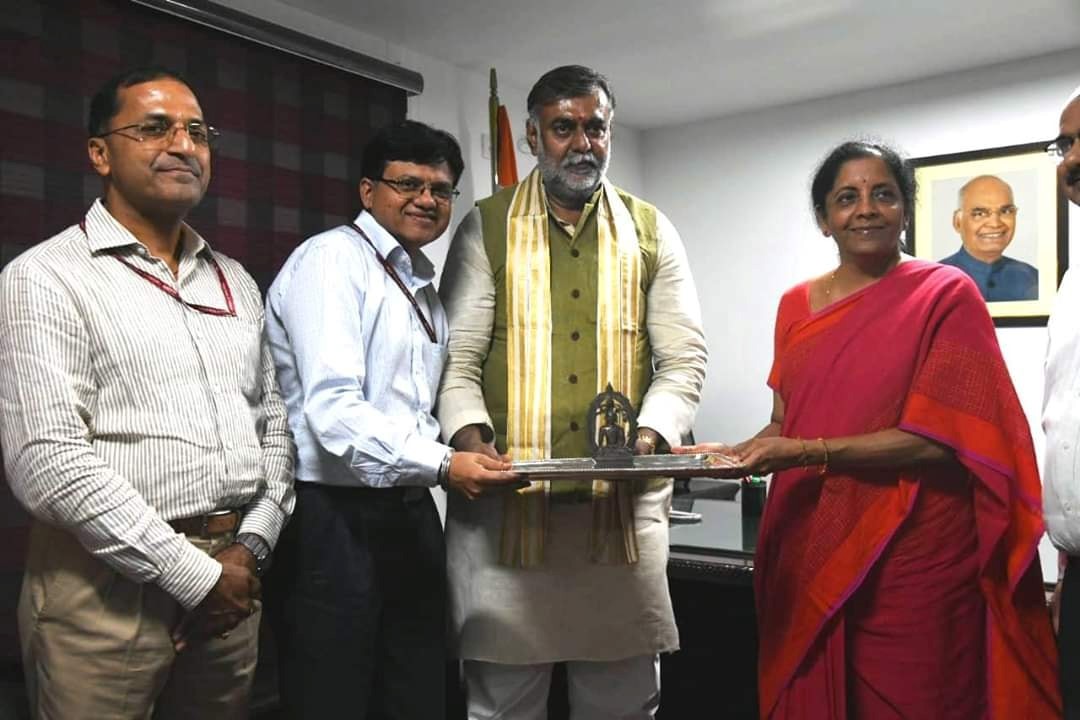
All the images are provided by the author.



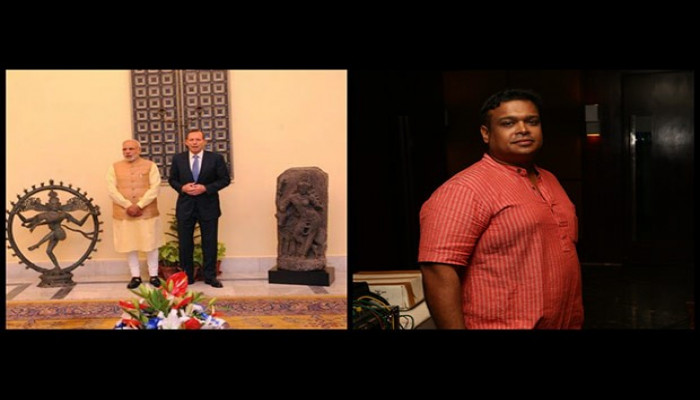
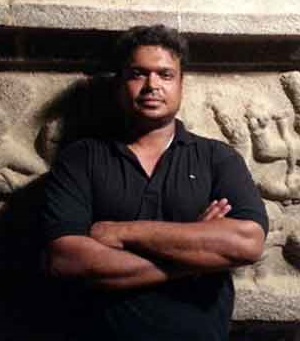


Comments